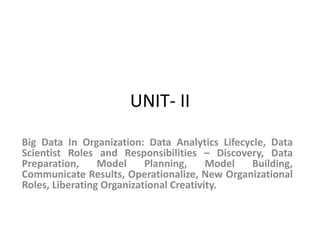
Big data in organisation on Hadoop .pptx
- 1. UNIT- II Big Data In Organization: Data Analytics Lifecycle, Data Scientist Roles and Responsibilities – Discovery, Data Preparation, Model Planning, Model Building, Communicate Results, Operationalize, New Organizational Roles, Liberating Organizational Creativity.
- 2. Big Data in Organization: • One of the more significant impacts of big data is the organizational change or transformation necessary to support and exploit the big data opportunity. Old roles will need to be redefined and new roles introduced, creating both opportunities and anxiety for individuals and organizations alike.
- 3. • Business intelligence (BI) and data science (involving advanced statistics, predictive analytics, and data engineering, programming, and data visualization) have very different roles and require different skills and approaches. • BI traditionally has focused on understanding key business processes at a detailed enough level so that metrics, reports, dashboards, alerts, and some basic analytics (trending, comparisons) can be built that support those key business processes.
- 6. • One of the biggest differences between the BI analyst and data scientist is the environment in which they work. BI specialists tend to work within a highly structured data warehouse environment. A data warehouse environment is typically production driven, with highly managed service level agreements (SLAs) in order to ensure timely generation of management reports and dashboards.
- 7. • The data scientist, however, creates a separate analytic “sandbox” in which to load whatever data they can get their hands on (both internal and external data sources) and at whatever level of granularity and history they need. Once within this environment, the data scientist is free to do with it whatever they wish (for example, data profiling, data transformations, creation of new composite metrics, and analytic model development, testing and refinement).
- 9. Data Analytics Lifecycle • Successful big data organizations continuously uncover and publish new customer, product, operational, and market insights about the business. • Consequently, these organizations need to develop a comprehensive process that not only defines how these insights will be uncovered and published, but clearly defines the roles, respon- sibilities, and expectations of all key stakeholders including the business users, data warehouse managers, BI analysts, and data scientists. • Let’s use the analytics lifecycle to gain an understanding of how these different stakeholders collaborate
- 12. This flowchart highlights the key responsibilities for each major stakeholder: • The business user (which also includes the business analyst) is responsible b for defining their key business processes, and identifying the metrics and key performance indicators against which those business processes will be measured. The business users are the ones who understand what questions they are trying to answer and what decisions they are trying to make. The business users are the ones who are trying to leverage the available data and insights to answer those questions and make those decisions.
- 13. • The data warehouse manager (or DBA in some cases) is responsible for defining, developing, and managing the data platform. • The traditional tools of choice for this stakeholder has historically been data warehouses, data marts, and operational data stores. • However, new technology innovations are enabling the data warehouse manager to broaden their role by considering new technologies such as Hadoop, in-memory computing, and data federation. • These new data platforms support both structured and unstructured data and provide access to data located both inside the organization as well as select data sources that exist outside the four walls of the organization. • These modern data platforms also support the ability to ingest and analyze real-time data feeds and enable the “trickle feeding” of data into the data platform.
- 14. • The data scientist is responsible for mining the organization’s data—struc- tured and unstructured data that is both internal and external of the organi- zation—to uncover new insights about the business. • Data scientists are data hoarders, seeking out new sources of data that can fuel the analytic insights that power the organization’s key business processes. • The data scientist needs a work environment (analytic sandbox) where they are free to store, transform, enrich, integrate, interrogate, and visualize the data in search of valuable relationships and insights buried across the different data sources.
- 15. • The BI analyst is responsible for identifying, managing, presenting and publishing the key metrics and key performance indicators against which the business users will monitor and measure business success. • BI analysts develop the reports and dashboards that the business users use to run the business and provide the “channel” for publishing analytic insights through those reports and dashboards to the business users.
- 16. • And finally, the analytic process circles back to the business users who use the result- ing reports, dashboards, and analytic insights to run their business. • It is the business users, and the effectiveness of the decisions that they make, who ultimately determine the effectiveness of the work done by the data warehouse man- ager, data scientist, and BI analyst. • Finally, the results of the decisions that the business users make can be captured and used to fuel the next iteration of the analytic lifecycle.
- 18. Data Scientist Roles and Responsibilities –